Methods for controlling diseases and pests of violets
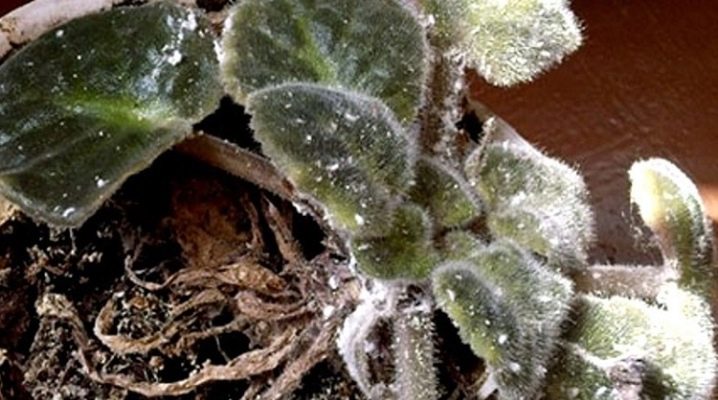
The beauty and grace of the saintpaulias, also known as the uzambar (African) violets, have made them universal favorites in the world of indoor floriculture. Subject to careful care, they will delight you with rapid growth and abundant year-round flowering. Whereas their incorrect content leads to a loss of decorativeness, developmental delays and, as a result, a decrease in immunity and resistance to attacks by pests and pathogenic microorganisms. Let us find out what difficulties violets face when breeding Saintpaulias, how these rosette plants most often get sick, how to protect them from infections and keep them healthy.
Despite the fact that Saintpaulia is botanically unrelated to the real representatives of the violet family (Violaceae), its second name is the Usambara violet, but at the same time it belongs to a completely different Gesneriaceae family. Although the article deals specifically with Saintpaulia, we will use both the official name and the name of the violet flower, which is more familiar to many.
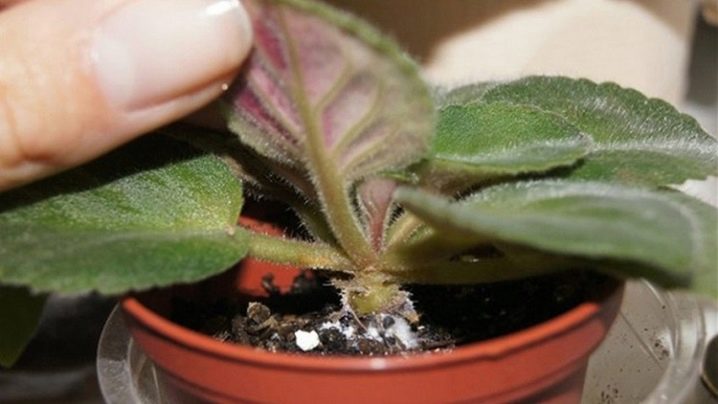
Frequent growing problems
Saintpaulia, as a native of the African continent and a typical representative of the tropical flora, requires conditions that are as close as possible to those characteristic of its historical homeland for full growth and development. In inappropriate conditions of detention, the outlet loses its visual appeal, begins to hurt and often dies. Let's look at examples of how this flower reacts to violation of certain rules of maintenance and care.
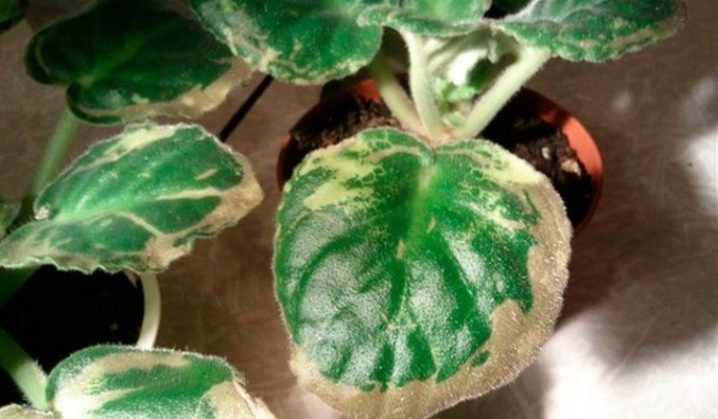
Spots on the leaves
The Uzambara violet likes bright, but diffused lighting, and being in direct sunlight is contraindicated for it. Deficiency or excess of light can cause discoloration of leaves, which in healthy plants have a bright green color. Due to excessive light, they turn yellow, become covered with brown spots, which indicates a sunburn, and sometimes begin to fall off. Although the duration of daylight hours for violets should be at least 12 hours, the brightness of the light should be moderate. There are the following reasons for the formation of spots on the leaves:
- insufficient (excessive) air humidity;
- incorrect watering regime (underfilling, overflowing, watering with cold water);
- oversaturation of the soil with nitrogen-containing fertilizers.

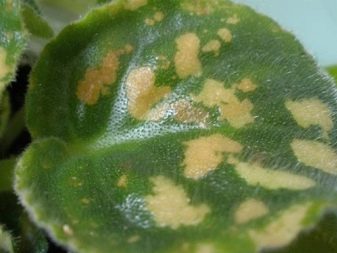
Leaves stretched up
This is direct evidence of incorrect light or temperature conditions. When a flower pot is placed on a windowsill with windows facing the sunny side, the plant often suffers from an excess of light. To protect himself from the aggressive sun, he has to lift the leaves. A similar situation can be observed when organizing artificial lighting, when lamps with the wrong power and brightness are used.
A violet with leaves raised upward may experience discomfort from close proximity to heating devices and, by deforming the outlet, tries to protect itself from the heat flow. If it is too hot in the room, then the brightness of the color of the petals disappears.
Important! Saintpaulias need a stable air temperature within + 15– + 25 ° C.
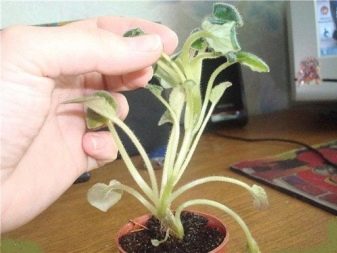
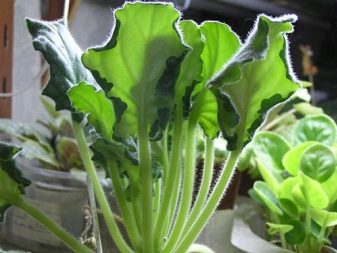
Leaves dry and turn black at the edges
There are such reasons for this phenomenon as:
- waterlogging of the soil;
- insufficient content of micro- and macroelements in the soil substrate;
- poor soil: too dense, heavy or overly compacted near the roots; violets feel good in light peat soil with a baking powder (sphagnum, perlite, vermiculite);
- stay in a draft, which the outlets really do not like.
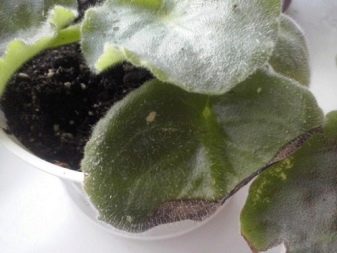

Leaves curl inward
If the leaves of a violet are curled, then this is usually due to excessive watering. A less common reason is growing a flower in nitrogen-saturated soil. It can also be a sign of phytophage damage.
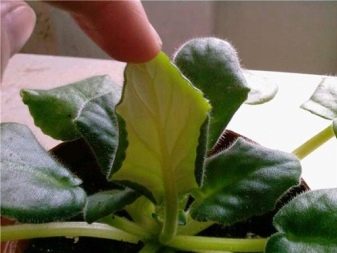
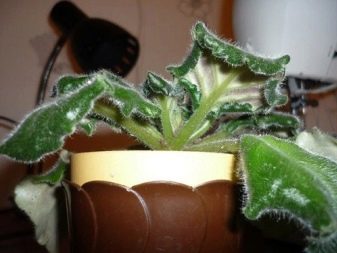
Leaves become soft and wither
A healthy violet, properly cared for, is a plant with fleshy, shiny, well-pubescent leaves on straight petioles pointing slightly upward. Soft, drooping leaves in them may be the result of a violation of the irrigation and feeding regime (deficiency of potassium and nitrogen or abuse of fertilizer), insufficient illumination of the place in which the pot with the plant stands.
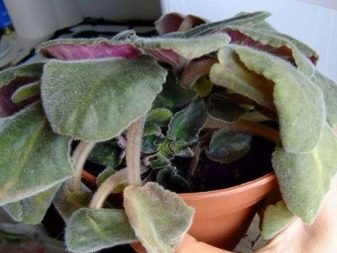
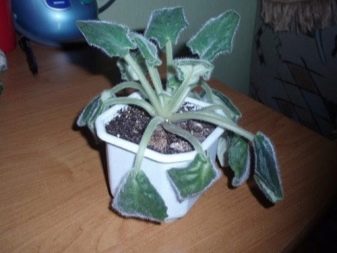
Common diseases
Most violet diseases can be successfully treated, provided that the owner takes appropriate measures in a timely manner and does not neglect prevention.
In order to diagnose certain diseases in time, you need to know and be able to recognize their symptoms.
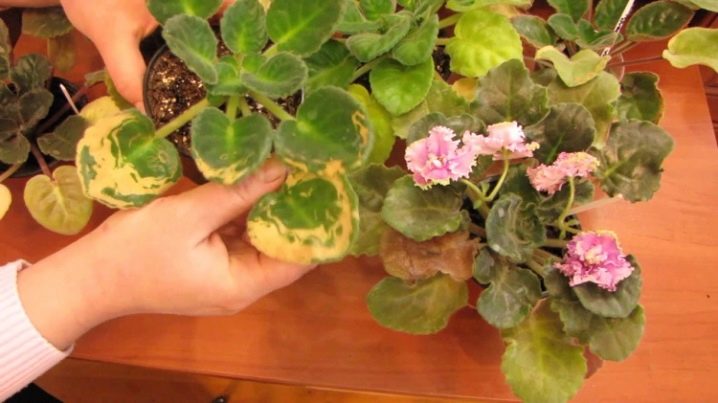
Fusarium
Stressful conditions of detention reduce the immune defenses of plants, making them extremely vulnerable to various pathogens. Mushrooms of the genus Fusarium show an increased interest in weakened Saintpaulias... Penetrating into young root shoots, the pathogen affects the conductive tissues that form a continuous branched system in the flower body that connects all organs: roots, stem, leaf stalks, peduncles.
After germination of the root system in the trachea, the fungus blocks the access of water and nutrients. The onset of the disease is characterized by the slow wilting of the violet, after which the leaves begin to die one after another, decomposing and turning into a jelly-like slurry.
At the last stage, blackening of the leaf petioles and stem can be observed, which indicates that the plant no longer has a chance of survival.
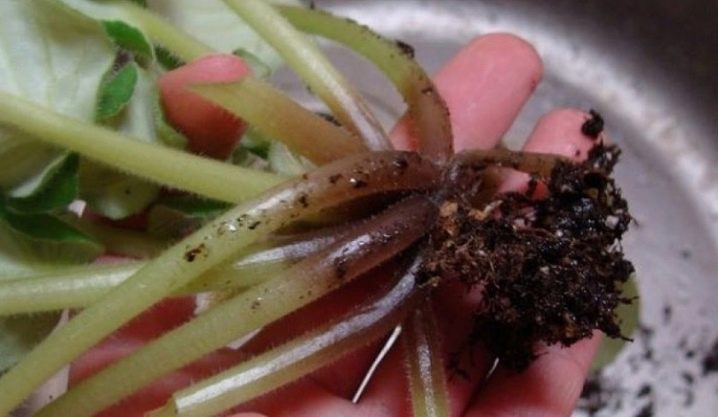
Vascular bacteriosis
This disease is considered the most severe among diseases of violets of infectious etiology. Its occurrence is primarily provoked by hot weather. When the thermometer is stable at + 27– + 30 ° C, the conductive plant tissues accumulate increased concentrations of ammonia, which burns the trachea, since the process of its removal in the heat is completely disrupted.
The disease develops when the green parts of the plant are self-poisoned with hydrogen nitride, whose sediment volume increases according to the increase in air temperature. Further, bacteria spread with lightning speed on the weakened tissue of the leaves and clog the trachea.
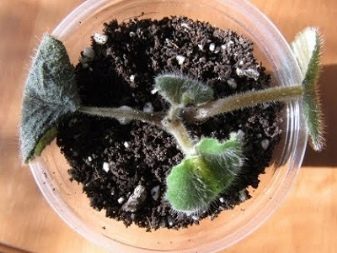
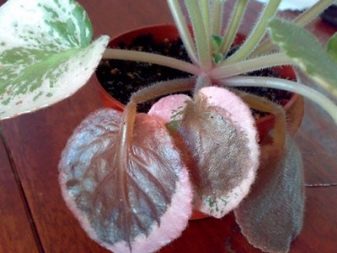
There are factors that cause bacteriosis, such as:
- improper watering with waterlogging of the earth, which disrupts its aeration and root respiration of plants;
- phosphorus and potassium deficiencies;
- stay in heavy soil, which provokes a violation of air exchange and the development of putrefactive processes.
Signs of summer bacteriosis at different stages of development are as follows:
- the appearance of small translucent watery brownish spots of an angular shape on the green parts of violets;
- localization of bacteria parallel to the conducting bundles in the leaf plates;
- the leaves become shiny, as if glass, and then begin to darken, become slimy, acquiring the consistency of jelly;
- mass death of leaves and death of a flower.
Important! Bacteriosis is difficult to treat, as it is fleeting - an adult flower dies within 24 hours. One thing is good: the disease is not able to spread to nearby flowers.

Powdery mildew
The causative agents of this fungal infection are erysipheus (powdery mildew) parasitic fungi. Dew outbursts occur in spring at the end of the heating season or before it begins in the fall. The following conditions contribute to the development of the disease:
- low temperature combined with high humidity;
- lack of light;
- imbalance of mineral compounds in the earthen mixture, when nitrogen is present in excess, and potassium and phosphorus are in insufficient quantities.
In an infected plant, all green parts (leaves, shoots, inflorescences) are covered with a white powdery coating, as if the plant was sprinkled with flour, which explains the name of the disease. Other manifestations of the disease are as follows:
- curling, wilting and falling of leaves;
- loss of leaf turgor, the integumentary membrane of which becomes uneven and covered with shallow ulcers;
- the formation of white spots on the petals of violets of purple color;
- stop in the development of shoots and buds;
- general suppression of the state of the plant and growth retardation.
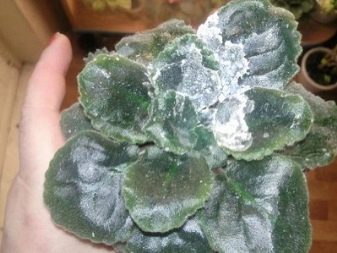

Late blight
The causative agent is a parasitic fungus from the genus Phytophthora. Late blight is characterized by a high degree of infectiousness, rapid spread and course. The main sources of infection are contaminated soil mixture and infected planting material. The following factors provoke the development of the disease:
- excessive watering;
- insufficient lighting;
- sharp temperature drops.
Signs of late blight lesion are as follows:
- wilting of the plant, despite the moist soil in the pot;
- decay of the root system, followed by rotting of the stem and leaves;
- loss of turgor, which ceases to recover after watering;
- rapid drying and mummification of leaves;
- change in color of roots to brown, partial or complete death of the root system.
Important! Late blight takes about 4–5 days to completely destroy the plant.

Gray rot (botridiosis)
An infectious fungal disease caused by the fungi Botrytis cinerea. The main routes of infection are contact with infected specimens, through splashing water during irrigation and spraying, or soil with the remains of infected plants. The development of the disease is facilitated by conditions such as:
- increased air humidity in combination with low air temperature, in particular, a decrease in t below + 16 ° С;
- abundant and careless watering with wet leaves and / or petals;
- poor air circulation due to insufficient ventilation of the room with violets.
Fungi-pathogens, first of all, show an increased interest in the dying parts of Saintpaulias - dried diseased flowers or damaged leaves, although under favorable conditions they often affect healthy flowers.
At different stages, the following characteristic manifestations of the disease occur:
- the appearance of the finest filaments of mycelium on the outlet;
- a change in the turgor of the leaves - having lost their elasticity, they look weak and lifeless;
- loss of normal color of leaves and stem, the surface of which is covered with uneven small spots of brown color;
- the appearance of a grayish fluffy mold on the green parts of the plant and flowers;
- softening of the affected areas, followed by drying and death.
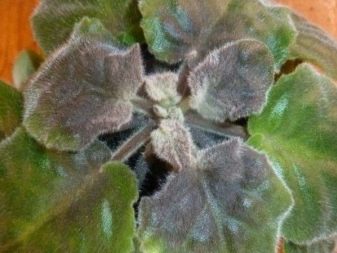

Pests
Insects, from which violets suffer, are of two types: sucking and leaf-eating. It is worth considering the most common pests of these plants.
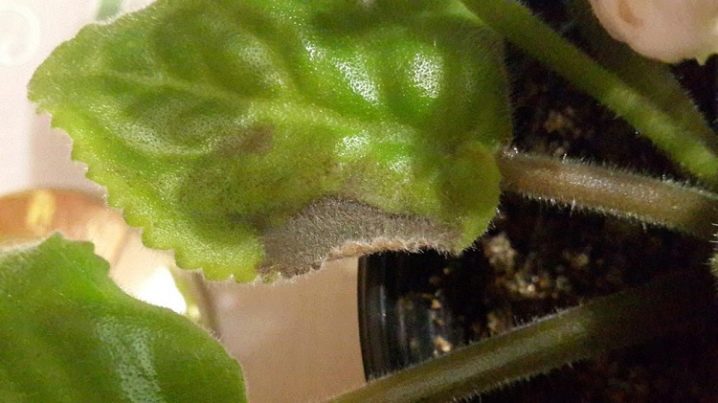
Mites
Saintpaulias are attacked by several species of ticks, some of which are so small that they can only be detected with a microscope. We are talking about a cyclamen (strawberry) tick, which can only be identified by changes in the appearance of violets. Red spider mite phytophagous inflicts no less damage on violets. This pest can already be identified without a microscope by a scattering of small red dots surrounded by cobwebs. Regardless of the species, the location of the colonies of ticks and their larvae are unchanged.
This is the point of growth of the rosette, incipient buds, young leaves, folds at the base of the leaf petioles, that is, places with high humidity, on which the well-being of this pest depends.
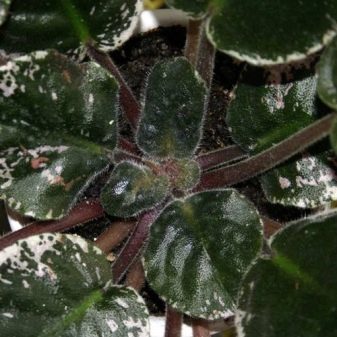
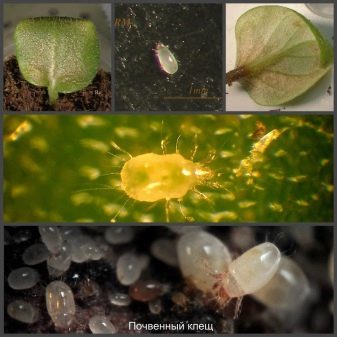
By the following external signs, it is possible to determine the defeat by phytophages:
- slowdown in growth;
- deformation of leaves in the central part of the rosette, they become small, curved;
- shortening the stem and leaf stalks;
- The "powderiness" of the bases of the leaves, on which a gray powder was poured;
- deformation of flowers that stop blooming and stop the development of buds;
- curliness and crowding of young leaves;
- drying of affected leaves;
- modification of the outer part of the leaf blades - many small punctures appear on the surface, and it itself becomes rough;
- the dying off of the point of growth of the flower and the death of the plant.
The vitality of phytophagous mite eggs is amazing: they remain viable for 4–5 years.
Damage by parasites of any kind threatens violets with an inevitable loss of visual appeal due to the curling of the leaves inward and the lack of flowering.


Thrips
These small dipterans, red-brown insects, 0.1–0.15 cm in size, tend to spread at high speed, which is largely facilitated by the ability to fly. So, to double the population size during the heating season or summer season, when it is warm and dry, they need a maximum of 6 days. At this time, the entire collection of violets is usually affected. Both leaves and inflorescences of Saintpaulias serve as a nutritional base for thrips. They lead a secretive existence and successfully hide in the depressions between the base of the leaves and the stem, microsporophylls of flowers and flower buds. It is quite problematic to see pests with the naked eye, usually the presence of uninvited guests gives out traces of their daily life, namely:
- the appearance on the outside of the leaves of colorless and light yellow stripes or intermittent silvery lines;
- the formation of spots on the surface of damaged leaf plates, on the outside of the leaves they are light, and on the inside they are brown-red.
The following signs of thrips are possible:
- deformation of the leaves, followed by curling inward in case of severe damage;
- the presence of spilled pollen on flowers with a dark, most often intense blue color;
- irregular shape and untidy appearance of flowers;
- short flowering.
After a long cohabitation with thrips, tender Saintpaulia turns into a plant with semi-wilted flowers and strongly deformed leaves into a small black and white speck (specks of white are traces of bites, and black ones are excrement).
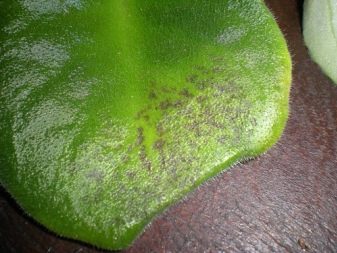
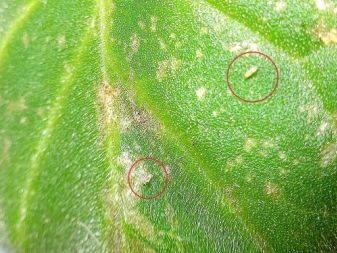
Aphid
This is a large group of pests that suck sap from plant cells. Their body is small, with a maximum of 7 mm. This type of sucking insect harms all organs of Saintpaulias: leaves, flowers, stem, root system. Another feature is that they do not live alone, but form rather large groups. Young leaves are chosen for life, preferring the reverse side, or they are placed around young stems. They are characterized by average mobility and the ability to reproduce quickly: if conditions are favorable, females can lay up to 25 eggs during the day.
The appearance of pests is difficult not to notice, since their clusters are clearly visible to the naked eye, plus there are many other signs of aphid damage to violets, namely:
- characteristic traces in the form of sticky shiny secretions covering the surface of the leaves, the formation of sooty fungi colonies on the sticky substance;
- yellowing of the affected green parts of the plant, in advanced cases they lose their color;
- leaf deformation, twisting and falling off;
- stopping the development of peduncles, the flowers of which open, but immediately fade.
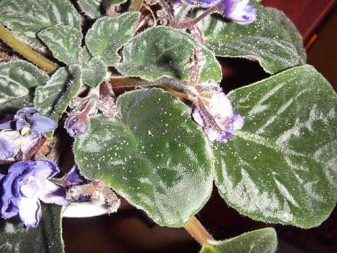

Schervets
The greatest danger to Saintpaulia is represented by root worms. At first, their presence is almost impossible to determine due to their small size (up to 5 mm) and due to the fact that almost all stages of their life cycle take place in the ground.Although the insects can choose young flower stalks and green parts of plants for life, climbing into the sinuses or folds of leaf plates, but the place where most of the population lives is precisely an earthen lump.
Worms are underground inhabitants that come to the surface and consider the terrestrial organs of plants as food only in cases of mass reproduction.
They can easily move to neighboring flowers, and placing pots in common pallets only simplifies their task.
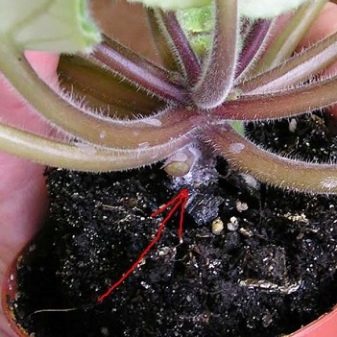

Signs of root worm damage are as follows:
- the formation of a whitish coating that looks like ash or mold on the roots;
- the appearance of light lumps of small size covering the walls of the pots, which is especially noticeable on dark containers;
- the presence of discharge in the form of whitish fluff on the bottom of the stem;
- the appearance of an extraneous smell from the ground, similar to the smell of mushrooms;
- slow development, poor and rare flowering of the affected plant, despite the ideal conditions of detention;
- loss of turgor and brightness of the color of the leaves.
Due to multiple damage to the roots of Saintpaulia, immunity and resistance to diseases are greatly reduced, so the death of a plant is only a matter of time.
The weakened violet is "finished off" by secondary infections of bacterial or fungal etiology.
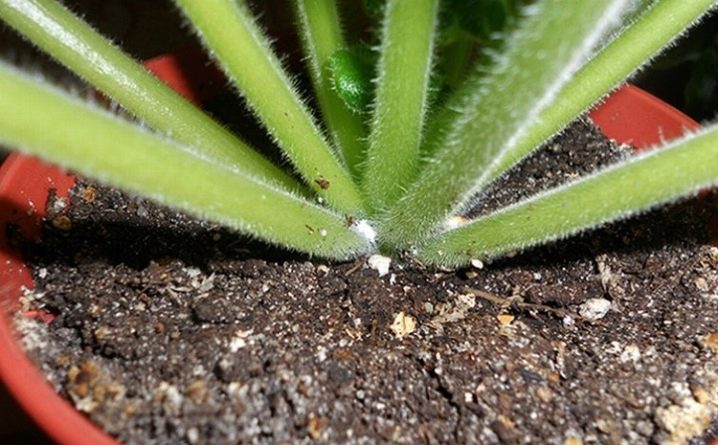
Another species is no less insidious - the mealybug. The nutritional base for these pests is young shoots, buds and leaves, from which they suck out cell sap. In addition to the fact that in this way violets are deprived of the lion's share of vital compounds. Due to the saliva secreted by the worms during feeding, metabolic processes are disrupted in plants. The signs of pest damage are as follows:
- the formation of a fluffy bloom, similar to cotton wool, covering the surface of the flower;
- cracking of the skin of the stem;
- browning and falling leaves;
- retardation of plant growth;
- depression of the general condition;
- weak flowering;
- rapid wilting, loss of decorativeness and deformation of bite sites in the event of mass destruction.
Due to the constant loss of juice, the host plant becomes weak, vulnerable to secondary infections and often dies.
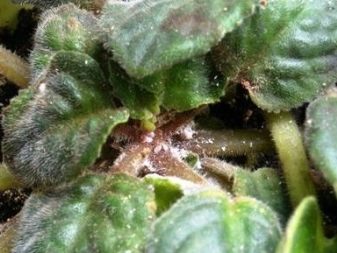
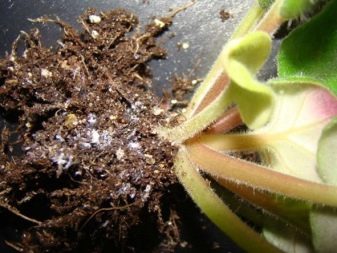
Nematode
Tiny filamentous non-segmented worms only 0.5-0.13 cm long, provoking the development of nematodosis - a disease from the category of rot. There are several types of nematode worms. Attacks by gall nematodes (melodogin) cause the formation of galls - red-brown formations on rotting roots. Due to leaf nematodes (aphelenchoidids), violets suffer from leaves and rudimentary shoots, and stem - they are stem parasites that can also migrate to leaves or flowers.
What unites all these types is that they are incredibly difficult to get rid of, as they have acquired extreme resistance to pesticides. Eating nematodes tend to secrete digestive enzymes in the tissues of host plants, which have a depressing effect, but do not cause the death of green organisms.
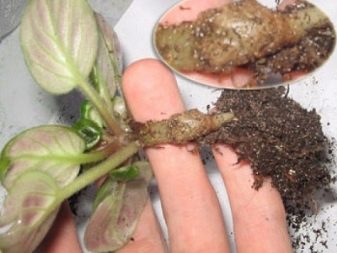
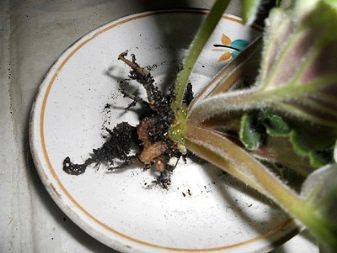
Although true identification of nematodes is only possible in a laboratory environment, there are the following signs by which you can determine that the plant is affected by these pests.
- the appearance of yellowish spots on the leaves;
- thinning and drying of leaves;
- oppression of the general condition and lack of flowering or the formation of ugly flowers: asymmetrical, hard and small;
- stretching and thickening of the stem;
- slowing down or stopping plant growth;
- asymmetry of the socket top;
- shortening of peduncles and petioles;
- "Layering" of numerous tops of the heads on top of each other;
- fragility, excessive pubescence, dullness of the leaf plates.
Important! In the affected violets, immunity is greatly reduced, and photophobia may also occur. The routes of infection are through common trays, earth mixtures, leaves from other plants.
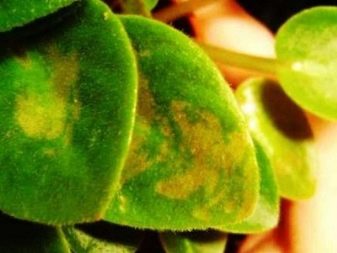

Ways to fight
When signs of damage are detected, Saintpaulia first of all, you need to perform such actions as:
- urgently isolate the problem specimen from neighboring plants;
- conduct a thorough examination of all nearby green pets to identify other foci of infection;
- prepare plants for treatment by removing and destroying all damaged organs;
- disinfect shelves, tools, equipment (pots, pallets, balcony boxes).
The pots are disinfected with "Bioderm", the surfaces are first sprayed with a 3% solution of hydrogen peroxide, and then with 5% table vinegar. This should be done in order to prevent the spread of infection.
Depending on the scale of the disaster, the fight against pests and diseases of violets is carried out with the use of potent pesticides or folk remedies and biological products based on plant raw materials (infusions, decoctions).
The main advantages of using natural insecticides to eliminate insects are their complete safety for human health, the lack of the ability to accumulate in plant tissues and the rapid loss of toxicity.
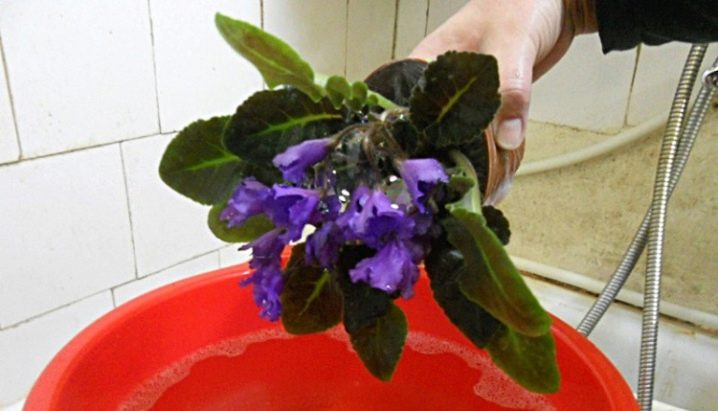
Protector plant | What pests helps | Spray infusion recipes |
Marigold | Aphid | A bucket with a volume of 10 liters is half filled with plants (fresh or dried), filled to the brim with warm water, insisted for 48 hours. |
Dandelion | Ticks, aphids | Pour chopped roots (200 g) or fresh leaves (300 g) with 5 liters of water t up to + 40 ° C, let it brew for 3 hours. Processing is carried out twice with an interval of 10-12 days. |
chamomile | Ticks, aphids | Pour chopped flowers (75–100 g) with 5 liters of water t + 60 ° C, leave for at least half a day. Squeeze and filter. Before processing, the concentrate is diluted with water in a ratio of 1: 3. |
Tobacco | Thrips | Pour tobacco (50 g) with water (1 l), leave for 48 hours, strain, add 4–5 g of soap shavings. |
Yarrow | Aphids, ticks | Pour 40 g of dry raw materials with boiling water and leave for half an hour, then add 5 liters of water, let it brew for 48 hours and strain. |
Garlic | Aphids, thrips, fusarium, gray rot, late blight | Place a few grated onions in a hermetically sealed container, pour water in a 1: 1 ratio, leave to infuse for 8-10 days. Dilute 20 ml of concentrate with 10 liters of water and spray the plants. |
Celandine | Aphids, bugs, caterpillars, fleas | 100 g of dry raw materials (leaves, shoots) pour 5 liters of water, leave for 48 hours. |
Important! It is recommended to process flowers in the morning or evening, with breaks between procedures for 6-9 days.
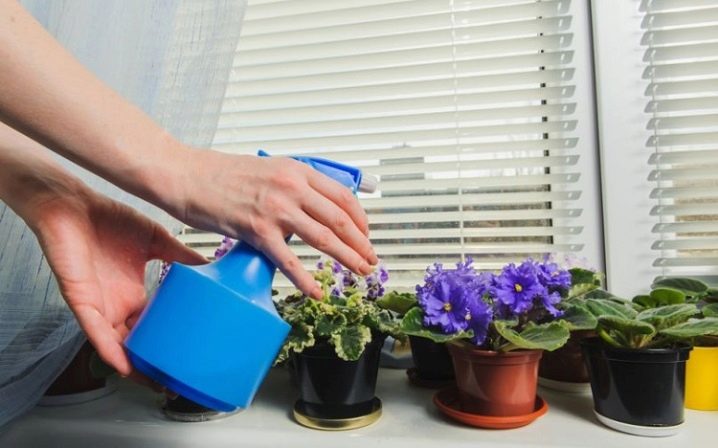
It is advisable to resort to the help of chemicals only in cases of massive attacks of pests and pathogens. At home, pesticides of I and II hazard classes must not be used.
Pests / Diseases | Preparations and methods of struggle |
Mites | Treat all surrounding plants with acaricides and insectoacaricides. Spraying preparations - "Fitoverm", "Vertimek", "Fufanon", "Inta-Vir", "Agravertin". |
Nematodes | Destroy the affected plant along with the soil, disinfect the pot. |
Aphid | Treat plants with Inta-Vir, Fitoverm, Fufanon, Agravertin, Aktara, water-dispersible granules (WDG), Iskra. The frequency of spraying is once a week. |
Schervets | The soil is spilled with a solution of "Regent", "Mospilan", "Dantop", "Aktara" three times with an interval of 8-10 days. |
Thrips | Treat the entire collection 5 times with a 6-day interval between procedures, alternating drugs to choose from: "Fufanon", "Aktara", VDG, "Fitoverm", "Vertimek", "Aktofit", "Confidor", "Tanrek". |
Legs (podura) | With a slight defeat, the drying of the earthen coma helps, in the event of a mass attack, the earth must be shed with "Pyrethrum", "Agravertin", any insecticides. Springtails have developed resistance to Aktar, so it is better to use Dantop. |
Fusarium | Treat the plants with Trichophyte or Infinite.Further, a monthly two-time strait of land by "Benomil" ("Fundazol") is recommended, in case of mass destruction more often. |
Vascular bacteriosis | During May, transplant the entire collection of violets into fresh soil mixture. In cases of minor damage, treat the plants with a solution of "Epin", "Zircon", "Previkur" or "Trichodermina". |
Powdery mildew | To save the violets, at the initial stage of infection, they are treated with "Topaz" or "Sapropel", which can neutralize fungi. With advanced forms of the disease resort to the use of "Triadimefon" ("Bayleton"). Other drugs used are "Previkur", "Ridomil Gold MC", "Profit Gold", "Amistar Extra", "Flint". |
Late blight | For watering and medicinal spraying, use a solution of "Trichophyte" or "Infinito". In the presence of living roots, it is possible to transplant the violet into a sterile substrate, into a smaller pot. |
Gray rot | For therapeutic spraying, use a 0.1% solution of any contact-systemic fungicide, for example, Topsin M, Teldora, Sumileks, Triforina, or a mixture of 2 g of copper sulfate and 200 g of soap shavings. The frequency of treatments is 1 time in 10 days. |

Prophylaxis
Although prevention does not 100% guarantee that pests and diseases will bypass violets, it helps prevent sudden outbreaks of infections and massive uncontrolled insect attacks that can destroy the entire collection. Following the following basic rules for keeping Saintpaulias reduces the risk of infection to the possible minimum:
- to keep new copies of the collection in quarantine for 1–1.5 months;
- to increase natural immunity, spray violets with biostimulants ("Zircon", "Epin");
- disinfect the soil by steaming, freezing on the balcony in winter and spilling 0.01–0.1% manganese solution;
- to create favorable conditions for plants for life with air temperature + 19– + 25 ° C, humidity 55–60%, acid-base balance of the soil within 6.2–6.7 and with a daylight hours of 9–13 hours;
- carry out an annual transplant of adult plants into a pot with high-quality drainage and substrate;
- wash and decontaminate racks, window sills and equipment on a monthly basis;
- with the arrival of spring, carry out preventive treatment against pests, and at the beginning of autumn - against fungal diseases.
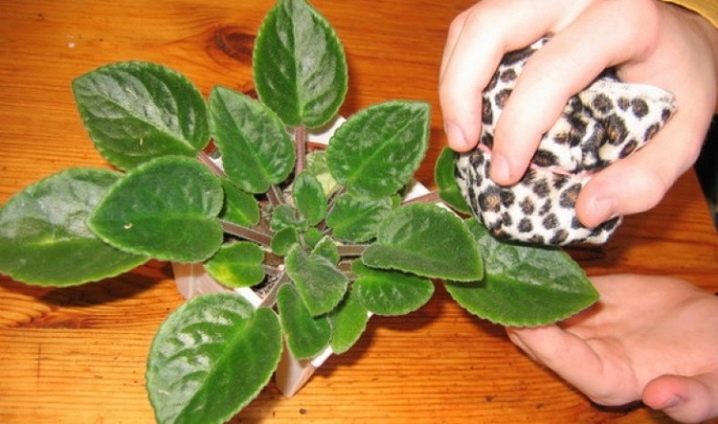
You can learn how to recognize pests on violets and what to do with them from the following video.































The comment was sent successfully.